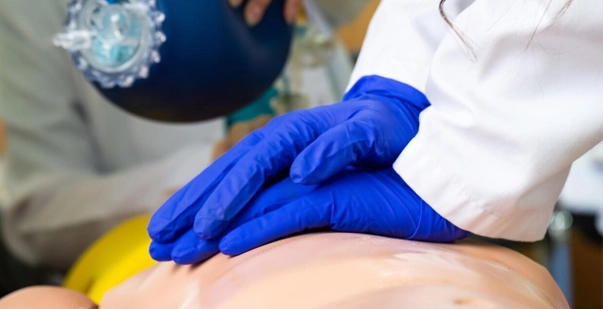Table of content:
- Why is CPR Important?
- What are the chances of CPR working?
- How Effective is CPR Outside of a Hospital?
- Understanding the Success Rate of CPR in Infants and Children
- What Are the Factors That Impact the Rate of Survival?
- From Knowledge to Action: Embracing CPR
Cardiac arrest kills more people than cancer, influenza, pneumonia, traffic accidents, HIV, and house fires combined globally. In that critical moment, the knowledge of CPR could be the difference between life and death. The likelihood of survival from witnessed cardiac arrest at various intervals to defibrillation has been demonstrated to be doubled or tripled by bystander CPR. This reality emphasizes the importance of CPR skills. Let us delve into the science behind how CPR’s chance of survival increases dramatically and provide actionable steps to equip you with this life-saving skill. By the end, you’ll realize why learning CPR is more than just admirable; it’s essential.
Master ACLS Now
Get ACLS certified with confidence
Why is CPR Important?
CPR is a necessary lifeline in cases of abrupt cardiac arrest. Survival rates may be greatly raised with this easy yet effective method. Let’s explore why CPR is so important and how it could change a life at a pivotal time.
-
Lifesaving Potential
CPR is a necessary lifeline in an emergency. When done right away, it may greatly increase survival rates. Studies reveal that bystander CPR increases the likelihood of CPR working in out-of-hospital cardiac arrests, either double or triple. The method buys time until medical help arrives.
-
Brain Preservation
The delicate character of our brain depends on continuous oxygen delivery. Without it, brain cells begin to die within minutes, perhaps causing lasting harm. The rhythmic chest compressions of CPR preserve blood flow, therefore supplying the brain with essential oxygen. This ongoing circulation helps maintain brain function, therefore avoiding long-term neurological damage.
-
Mimicking Heart Function
The temporary stand-in for the heart’s pumping motion is CPR. It maintains blood moving to all the visceral organs by combining chest compressions with sometimes rescue breaths. This temporary circulation increases the possibility of a successful resuscitation as it sustains life until advanced medical treatment is given.
-
Universal Accessibility
One of CPR’s most significant advantages is its simplicity. Regardless of medical training, anybody may learn and use fundamental CPR. The arrival of hands-only CPR has streamlined the procedure even further, hence increasing public accessibility to it. This general capacity for quick response in emergencies makes society safer for everyone.
Read More: complete BLS certification
CPR Success Rates: The Importance of Acting Quickly
Effective CPR increases survival rates by 3.9 times over poor-quality CPR. Outside hospitals, survival rates range from 12-24%, while inside, they reach about 40%. Time is of the essence; roughly half of individuals who get CPR within 3 to 5 minutes after collapsing survive. In addition, every minute delay lessens chances for survival.
A study found that after 12 minutes, less than 5% of patients survived. These stats show how often CPR is effective and highlight its importance. Good technique and fast response really make a difference. Learning CPR prepares you to save a life in emergencies.
How Effective is CPR Outside of a Hospital?
CPR may save lives outside of hospitals, but its effectiveness depends on various conditions. However, out-of-hospital cardiac arrests (OHCA) present unique challenges:
- Delayed recognition of cardiac arrest,
- Lack of immediate access to advanced medical equipment,
- The potential absence of trained medical professionals
- Variable response times for emergency medical services.
This difference results from faster access to advanced medical treatment in hospitals. Still, bystander CPR is very important in closing this gap.
- In cities where CPR training is widespread, out-of-hospital survival rates have been reported as high as 40-50% for certain types of cardiac arrests.
- The use of public-access defibrillators, along with CPR, can increase survival rates to 50-70% in some cases.
Though the figures might appear little, they reflect actual lives saved. In an emergency, some CPR is better than none.
Read More: CPR vs. BLS Training: What’s the Difference?
What Are the Factors That Impact the Rate of Survival?
A number of important variables might significantly affect survival chances after cardiac arrest. Knowing these elements allows us to appreciate the need for immediate intervention and appropriate CPR. Let’s explore the primary factors influencing the likelihood of survival after a cardiac arrest.
-
Effectiveness of CPR
Survival depends heavily on the quality of CPR. Good CPR can boost survival chances by 3.9 times compared to poor CPR. According to studies, 4.6% of those who received efficient bystander CPR survived, but just 1.4% survived when given insufficient CPR. This great disparity emphasizes the need to know the correct CPR technique.
-
Timing of CPR
A cardiac emergency counts every minute. Survival rates decline around 10% per minute without CPR. Early bystander intervention is especially important given this quick drop. Quick CPR could prevent a single cardiac arrest from developing into a double cardiac arrest situation when the heart pauses once again after the first revive.
-
Location of Cardiac Arrest
Where a heart arrest occurs affects survival rates. Public area cardiac arrests had better results than those occurring at home. Unfortunately, 7 of 10 out-of-hospital cardiac arrests happen at home. This usually results in fewer witnesses and a delay in beginning CPR.
-
Rhythm at the Time of CPR
The electrical activity of the heart during arrest affects survival. Shockable rhythm patients—those with ventricular fibrillation—have better survival rates. Asystole (no cardiac rhythm) frequently results in worse outcomes. The first rhythm may direct therapy choices and affect the success of therapies.
-
Duration of Resuscitation
Generally speaking, longer CPR attempts equal lower survival odds. Independent of anything else, the period of resuscitation determines whether or not someone will live to leave the hospital. However, certain examples of extended CPR do result in survival, demonstrating that perseverance may pay off in difficult circumstances.
Current Trends and Future Directions in CPR
As medical science advances, so too do the techniques and technologies associated with CPR. Several trends are helping to improve CPR effectiveness:
-
Compression-Only CPR:
Many organizations now recommend compression-only CPR for untrained bystanders. It is easier to perform and remember and eliminates hesitation related to mouth-to-mouth contact. Studies have shown it to be as effective as traditional CPR in many cases.
-
Mechanical CPR Devices:
Automated devices that deliver consistent, high-quality chest compressions are becoming more common as they reduce rescuer fatigue. They also ensure consistent depth and rate of compressions, which is particularly useful in prolonged resuscitation efforts.
-
Real-Time Feedback Devices:
Technologies that provide real-time feedback on CPR quality are improving outcomes and guiding rescuers on compression depth and rate. They help maintain high-quality CPR throughout the resuscitation effort.
-
Targeted Temperature Management:
Post-resuscitation care, including controlled cooling of the body, is improving long-term outcomes by protecting the brain from further damage. This is becoming a standard part of post-cardiac arrest care in many hospitals.
From Knowledge to Action: Embracing CPR
With the advent of technology and research, the chance of survival by CPR is expected to increase only. Therefore, being prepared to perform CPR will make all the difference in an emergency, whether at home, in business, or in public. When a bystander responds fast and courageously, the probability of survival might rise.
Learning CPR and advanced cardiac life support (ACLS) guarantees your readiness for an emergency and the possibility of saving the life of a loved one or even a stranger. Empower yourself with the knowledge to act when it matters most. Begin immediately by registering for an online CPR training course.







